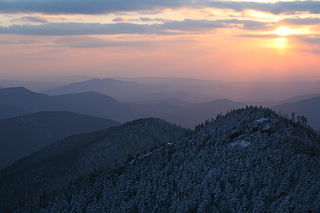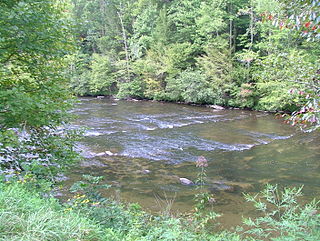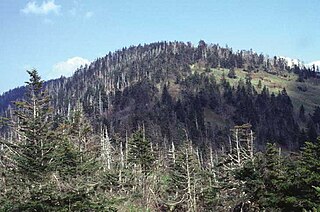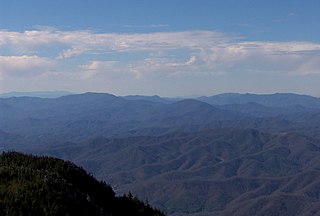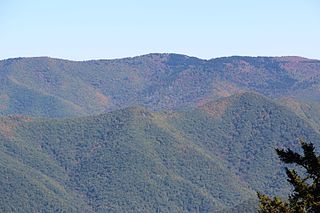| Tanasee Bald | |
|---|---|
Tanasee Bald viewed from the Blue Ridge Parkway | |
| Highest point | |
| Elevation | 5,561 ft (1,695 m) |
| Coordinates | 35°17′30″N82°55′03″W / 35.29177°N 82.91763°W Coordinates: 35°17′30″N82°55′03″W / 35.29177°N 82.91763°W |
| Geography | |
| Location | Haywood / Transylvania counties, North Carolina, U.S. |
| Parent range | Great Balsam Mountains Blue Ridge Mountains |
| Topo map | USGS Sam Knob |
| Climbing | |
| Easiest route | Hike [1] |
Tanasee Bald, also called Tennessee Bald, is a mountain near the Blue Ridge Parkway in western North Carolina, on the Haywood/Transylvania border. [2] It is 5561 feet high. It is in the Great Balsam Mountains within the Blue Ridge Mountains, which is part of the Appalachian Mountains

The Blue Ridge Parkway is a National Parkway and All-American Road in the United States, noted for its scenic beauty. The parkway, which is America's longest linear park, runs for 469 miles (755 km) through 29 Virginia and North Carolina counties, linking Shenandoah National Park to Great Smoky Mountains National Park. It runs mostly along the spine of the Blue Ridge, a major mountain chain that is part of the Appalachian Mountains. Its southern terminus is at U.S. 441 on the boundary between Great Smoky Mountains National Park and the Cherokee Indian Reservation in North Carolina, from which it travels north to Shenandoah National Park in Virginia. The roadway continues through Shenandoah as Skyline Drive, a similar scenic road which is managed by a different National Park Service unit. Both Skyline Drive and the Virginia portion of the Blue Ridge Parkway are part of Virginia State Route 48, though this designation is not signed.

North Carolina is a state in the southeastern region of the United States. It borders South Carolina and Georgia to the south, Tennessee to the west, Virginia to the north, and the Atlantic Ocean to the east. North Carolina is the 28th-most extensive and the 9th-most populous of the U.S. states. The state is divided into 100 counties. The capital is Raleigh, which along with Durham and Chapel Hill is home to the largest research park in the United States. The most populous municipality is Charlotte, which is the second-largest banking center in the United States after New York City.

Haywood County is a county in the western portion of the U.S. state of North Carolina. As of the 2010 census, the population was 59,036. Its county seat and largest city is Waynesville.
Contents
Tanasee Bald is the southern limit of breeding of the northern saw-whet owl, which is from the boreal forests of Canada. [3]

The northern saw-whet owl is a small owl native to North America. Saw-whet owls are one of the smallest owl species in North America. They can be found in dense thickets or conifers, often at eye level, although they can be found around 20 feet up. Saw-whets are often in danger of being preyed upon by larger owls and raptors. Saw-whet owls are also migratory birds without any strict pattern.

Canada's Boreal forest comprises about one third of the circumpolar boreal forest that rings the Northern Hemisphere, mostly north of the 50th parallel. Other countries with boreal forest, also called taiga, include Russia, which contains the majority, the United States in its northern most state of Alaska, and the Scandinavian or Northern European countries. The boreal region in Canada covers almost 60% of the country's land area. The Canadian boreal region spans the landscape from the most easterly part of the province of Newfoundland and Labrador to the border between the far northern Yukon and Alaska. The area is dominated by coniferous forests, particularly spruce, interspersed with vast wetlands, mostly bogs and fens. The boreal region of Canada includes eight ecozones. While the biodiversity of regions varies, each ecozone has a characteristic native flora and fauna.




